PageRank is a metric Google uses to decide which web pages appear at the top of the search results.
In the not-so-distant past, Google Page Rank was the talk of the SEO world. Back then, watching your score climb felt like hitting the jackpot because it was a sign your SEO strategy was working.
Today, while PageRank might not be the *** topic it once was, it’s still a part of Google’s story.
But let’s pull back the curtain and start with the basics.
In this article, we will take a look at:
Google PageRank is an algorithm that evaluates the importance of web pages and ranks them in search engine results based on the quality and quantity of incoming backlinks.
The philosophy behind PageRank is simple:
Your page has links pointing to it. Some of these links are high-quality, while others aren’t. The more high-quality links your page has, the more significant it is for Google. This is based on Google’s belief that more important websites receive more links.
As a result, Google will favor your page and push it higher in search results.
Google PageRank (in Google Toolbar) evaluated pages on a logarithmic scale, where scores ranged from 0 (PR0) for the lowest-quality pages, to 10 (PR10) for the highest-quality pages.
The logarithmic nature of PageRank meant that even a small increase in PR could dramatically boost a website’s authority.
It was believed that even increasing a page’s PR score by 2 (from PR4 to PR6) could benefit the website exponentially by approximately a factor of 25.
It seems confusing at first glance, but don’t worry. We’ll discuss everything below.
The story of PageRank begins at Stanford University in the late 1990s. Google’s co-founders, Larry Page and Sergey Brin, were exploring ways to improve information retrieval on the web.
At the time, search engines were struggling to rank pages effectively, so Page and Brin devised an idea to use links to measure a page’s importance.
This concept led to the creation of PageRank, the algorithm that set Google apart from its competitors. They published their findings in a paper (The anatomy of a large-scale hypertextual Web search engine) that transformed the chaotic web into a more organized search experience, and it was exactly what users needed.
In 1998, Page and Brin filed the first PageRank patent and marked the birth of a new era in search.
Since then, PageRank has undergone many updates. Here’s an overview of its milestones:
- March 15, 2000: Google makes PageRank public in the Google Directory. Google shut this directory down in 2011.
- December 11, 2000: Google introduces the Google Toolbar, which displays the PageRank score of any web page. This makes Page Rank a visible metric for the first time.
- June 17, 2004: Google files a patent describing the evolution of PageRank and how it assigns different weights to links based on their likelihood of being clicked.
- January 18, 2005: Google introduces nofollow links to fight comment spam.
- November 17, 2005: PageRank launches in Google Sitemaps (now Google Search Console). It was presented in the categories of high, medium, low, or N/A.
- April 24, 2012: Google launches the Penguin Algorithm Update aimed to reduce web spam and improve search results.
- October 16, 2012: Google introduces the Disavow Tool, an advanced feature that removes the links from another site to yours.
- December 6, 2013: Google updates Toolbar PageRank for the last time.
- March 7, 2016: Google removes PageRank from its browser toolbars. PageRank data is no longer available, but Google will continue to use it internally.
- January 9, 2019: The PageRank patent expires.
- September 10, 2019: Google introduces the rel=”ugc” and rel=”sponsored” link attributes to understand how people link. These attributes identified the nature of links on a website.
- June 23, 2021: Google launches the Link Spam Update to improve the quality of search results. It targets spam and algorithm manipulations.
- April 21, 2022: Google leverages SpamBrain, an AI-based spam-prevention system, more often to neutralize the impact of unnatural links.
- October 4, 2023: Google updates the spam detection system and improves the coverage in various languages and spam types, primarily cloaking, *******, auto-generating, and scraping.
- March 5, 2024: Google releases a core update that thwarts clickbait and promotes useful content. New spam policies can now better handle malicious practices.
Google Toolbar
Google Toolbar was a browser add-on created in December 2000. It provided users quick access to various search features directly from the browser.
This was huge at the time because it packed many important features into one place: pop-up blockers, autofill, and easy access to the search engine.
Google Toolbar is integrated directly into a user’s web browser. Once installed, it added a toolbar beneath the address bar with a search box, buttons for Google services, and the PageRank indicator.
It looked something like this:
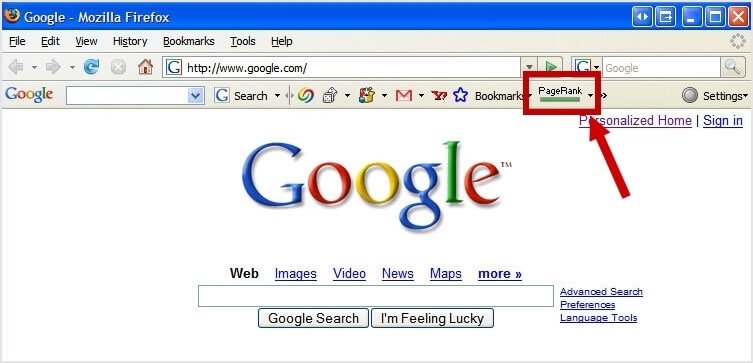
The Google Toolbar was officially discontinued on December 12, 2021, after almost 21 years since its launch.
The original website now redirects to Toolbar Support and provides instructions on installing Google Chrome. The search giant culled this project quietly, without so much as an announcement.
Google PageRank and the toolbar were canceled for a few reasons, one of the most prominent being SEO manipulation.
Black-hat SEOs would abuse the algorithm and web admins would use link spam to increase their scores illegitimately. They would chase higher scores by dropping links wherever they could, including forums and blog comments. After a while, Google had enough.
New PageRank algorithm
Google discontinued PageRank as a public metric on the Google Toolbar in March 2016. But even though PageRank was invisible to our eyes, it still worked behind the scenes.
In 2017, Gary Illyes (an analyst on the Google Search team) shared that PageRank still has a role in the algorithm, albeit not a leading one. Now, they’re mostly using it as a signal.
DYK that after 18 years we’re still using PageRank (and 100s of other signals) in ranking?
Wanna know how it works?https://t.co/CfOlxGauGF pic.twitter.com/3YJeNbXLml
— Gary 鯨理/경리 Illyes (so official, trust me) (@methode) February 9, 2017
In 2019, the original PageRank patent expired exactly 20 years after its creation. But a patent expiring means that it’s simply no longer enforceable by Google, not that its contents are now defunct.
Namely, PageRank was still a factor Google considered even after the patent expired.
A similar outcome happened in 2006 when Google replaced the original patent with a new, related algorithm that provided comparable results.
In 2020, in a series of tweets that have since been deleted, John Mueller (a senior search analyst at Google) confirmed that the search engine still uses PageRank internally:
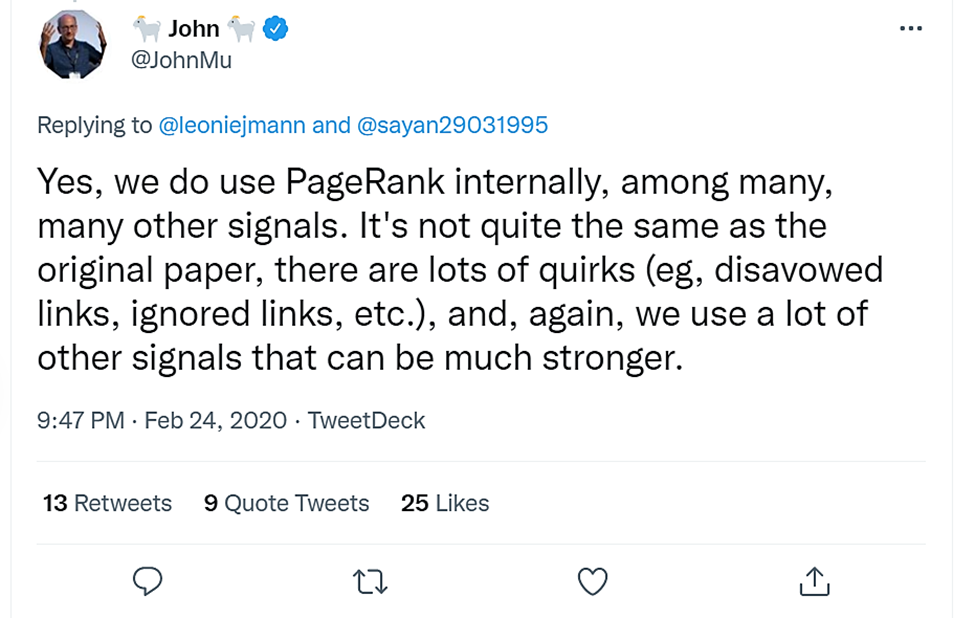
But now, it’s part of a much larger ecosystem and includes more quirks than the original paper describes, which is backed by the many Google ranking factors present today.
Nowadays, we don’t know how PageRank works and how influential it is in ranking.
Yet, in 2024, Google updated their SEO starter guide and dropped a line that surprised many – PageRank is still a fundamental ranking signal in the search algorithm.
While its original meaning seems unchanged, Google reiterates that there’s more to search than just links.
Google PageRank fundamentally changed SEO and provided a method to quantify the importance of web pages based on backlinks.
This played a key role in several aspects of SEO, including:
a) Website rankings
Page Rank was instrumental in determining how pages ranked in search results. After all, that’s the point of the metric – to decide rankings. The original paper by Page and Brin even says:
“Page Rank is an excellent way to prioritize the results of web keyword searches.”
Pages with higher PageRank scores indicated greater authority and relevance because of the number and quality of their backlinks. Each link to a page is a “vote” of confidence, but links from high-authority sites carry more weight.
Since Google prefers pages with authoritative links, such pages are more likely to appear at the top of search results.
b) Crawl budget
Page Rank influences how search engines allocate their crawl budget, i.e. the amount of resources dedicated to crawling and indexing pages on a site.
Google has to prioritize certain pages for crawling in some way, so using links is an easy way to determine which pages are more popular.
With this, Page Rank influences how often bots crawl the pages of your website. The bots prioritize pages with higher PageRank scores and subject them to more frequent checks.
Even Google itself has shared that URL popularity is a factor that plays a significant role in determining crawl demand.
c) Canonicalization
Google PageRank can, in some sense, influence which page will be perceived by Google as the canonical version of duplicate pages.
When multiple versions of a page exist, Google uses internal links that pass PageRank values (along with other signals such as sitemap, robots.txt, canonical tags, etc.) to decide which version should be indexed and ranked as the canonical page.
Google will likely select the page with more links pointing to it as the canonical version.
Although this feature ensures that the user encounters the most relevant page and finds the information they’re searching for, it is not the only value Google uses to figure out the canonical version (it’s just part of their process).
PageRank follows the principle that the quantity and quality of links pointing to a webpage determines its importance. Namely, the more inbound links a page has, the more votes of confidence it’s received.
In modern SEO, we call these votes of confidence “link juice.”
When Google crawls the pages, the algorithm calculates the Page Rank by considering the Page Rank of all linking pages.
Some time ago, SEOs would use nofollow attributes to manipulate the flow of PageRank and pass it only to certain pages.
This is called PageRank sculpting or link sculpting, and it’s on Google’s list of naughty practices.
Here’s how it worked:
You have a page with three outbound links, but you want your link juice to flow to only two of them. To direct juice to the two links, you add a nofollow attribute to the third, undesired one. That way, you funnel more PageRank to the important two pages.
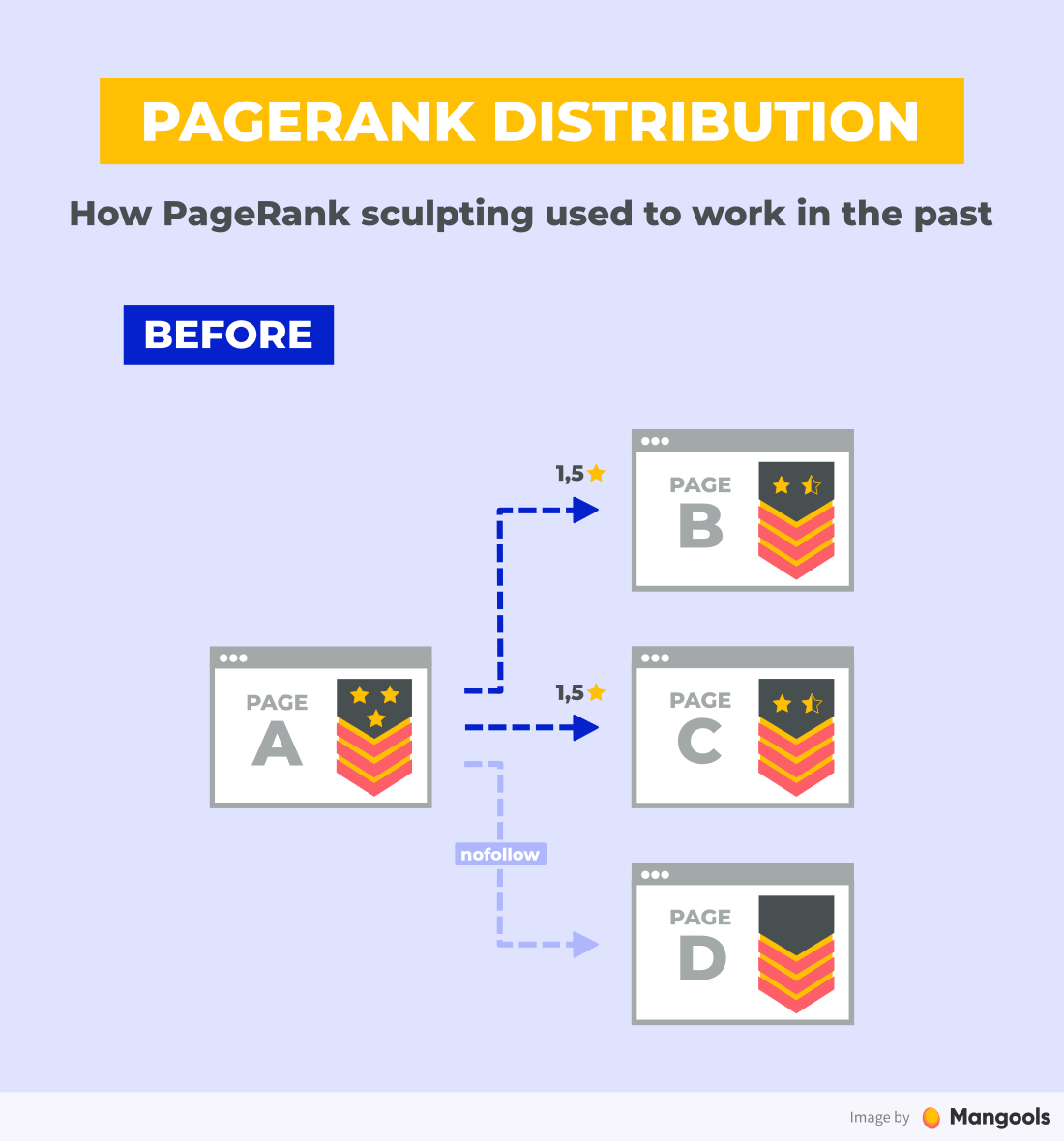
This practice has become obsolete since Google’s updated algorithm now ignores nofollow links when distributing PageRank.
Today, the pages you do want to link to won’t get more juice from sculpting. Instead, the potential PageRank you could’ve passed on is just… lost.
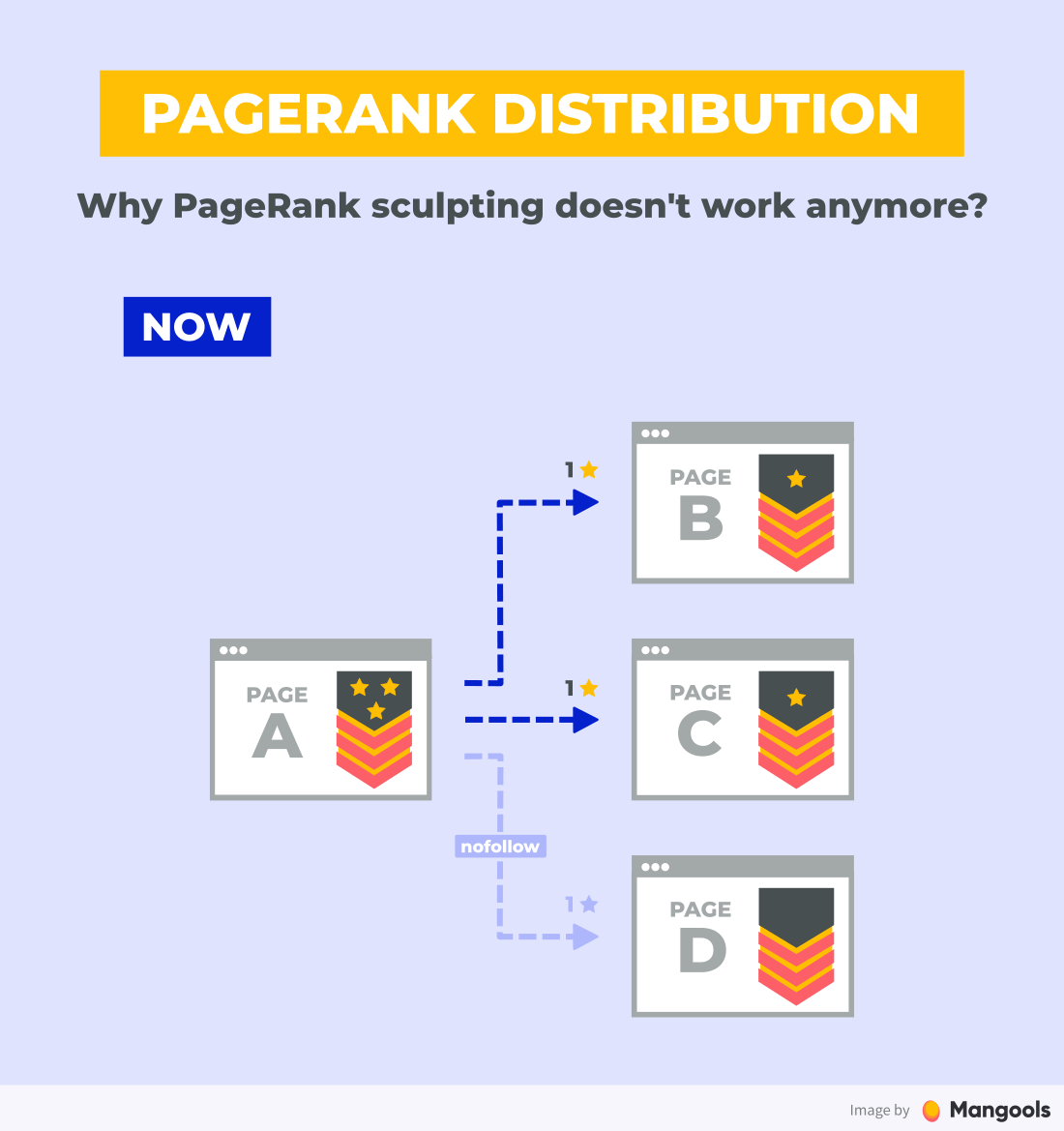
In 2009, Matt Cutts, a Google rep, advised against using the practice and confirmed that a nofollow attribute won’t cut it.
How to calculate Google PageRank?
To calculate Google Page Rank, the algorithm uses the following formula:
PR(A) = (1-d) + d (PR(T1)/C(T1) + ... + PR(Tn)/C(Tn))
Where:
- PR(A) is the PageRank of page A.
- d is the damping factor (the probability that a user will continue clicking on links and surfing the web, usually set to 0.85).
- PR(T1), PR(Tn) are the PageRanks of pages that link to page A.
- C(T1), C(Tn) are the total number of links going out of pages T1 to Tn.
PageRank weighs the significance of a particular page based on how likely it is for a user to click on it and assigns an even weight to all its outbound links.
So, if a page with a PageRank value of 0.4 links to two pages, each of them would get half its score, i.e. 0.2.
Let’s assume we have three pages: A, B, and C.
- Page B links to page A.
- Page C also links to page A.
For simplicity, let’s say that:
- PR(B) = 0.4 with two outbound links.
- PR(C) = 0.3 with three outbound links.
- d = 0.85 (the damping factor).
Then, we can calculate how much each page contributes to page A:
- Page B contributes: PR(B)/C(B) = 0.4/2 = 0.2
- Page C contributes: PR(C)/C(C) = 0.3/3 =0.1
Using the damping factor, we can calculate the PageRank of page A as:
- PR(A) = (1 – 0.85) + 0.85 [0.2. + 0.1]
- PR(A) = 0.15 + 0.85 [0.3]
- PR(A) = 0.15 + 0.255 = 0.405
Thus, PR(A) = 0.405.
Now, here’s when things get more complicated.
To optimize your site’s authority, you need to know the factors that influence Google Page Rank and try to solve any underlying issues, such as:
1. Number and quality of backlinks
Since Page Rank’s priority is assessing backlinks, the number and quality of links to a page is paramount.
As you now know, not all links are equal, so focus on getting votes of confidence from high-authority sites that can signal to Google that your content is trustworthy.
Campaign with the quality of your content!
The best links to help your PageRank will come from recognized authorities like governments, health groups, or official organizations.
If you can’t shoot that high, go after links from established magazines in your niche.
2. Anchor text
Anchor text, the clickable text in a hyperlink, provides context about the linked page’s content. If you want your users to understand where this link will take them, spell it out for them (and for Google) so they know the topic of the linked page.
For example, a link with the anchor text “SEO guide” (see what we did there?) is more relevant to a page than a generic “click here” link because you wouldn’t know what you’re going to get from the latter. Will it be a landing page? Another blog? A form?
Optimize, but don’t over-optimize because Google flags overuse of anchor texts, especially if they’re ‘exact match anchors.’
3. Internal links
Internal links, as the name suggests, connect different pages internally (within the same website).
Thus, they distribute PageRank throughout the site and create a group of connected pages. When interlinking, you distribute link juice among pages on a similar topic.
The more internal links a page receives, the higher its PageRank will be.
But since SEO likes making our lives harder, you’ll also need to be mindful that the more outbound links a page has, the less PageRank it has since it passes its score to the other links it points to.
4. Probability of a click on the hyperlink
Google’s PageRank algorithm incorporates the likelihood that a user will click on a hyperlink.
Pages with a higher likelihood of being clicked are more valuable to Google, and their PageRank will show that.
The reason for this is simple: user behavior. Google has determined which links users value and will push their ranks up to facilitate other users. According to Google, whether a user clicks a link depends on the placement, so:
- Popular links are at the top and have descriptive anchor text that passes more PageRank to the linked page
- Less visible links are buried at the bottom and will pass less PageRank
5. Link spam techniques
Unfortunately, some SEOs resort to using link spam techniques to manipulate their PageRank.
However according to Google, “any links that are intended to manipulate rankings in Google Search results may be considered link spam.”
Google regularly battles spam techniques and explicitly states that such practices can lead to penalties.
Common spam techniques include:
- Buying or selling links for ranking purposes
- Distributing links in footers or templates
- Automated linking programs
- Link exchanges
- Link farms
While these are some of the most prevalent techniques, Google has an entire list of link spam examples.
6. Nofollow link attributes
The nofollow attribute tells search engines not to pass PageRank through a specific link.
Google added this attribute to stop the misuse of comment sections of authoritative blogs to farm backlinks.
Since 2005, SEOs can prevent crawlers from following links they don’t want to be considered for link juice.
Google has also introduced “sponsored” and “ugc” attributes to categorize different types of links.
But while they guide how search engines handle these links, they’re not rules. Now they’re only hints Google uses, among other signals, to determine link relevance.
7. Number of outbound links on the page
A page with many outbound links distributes its PageRank among all its links. As a result, each link receives a portion of the PageRank.
This may sound counterproductive, but Google considers linking to external resources as a good practice.
In fact, it may even penalize you for not linking out to anyone outside of your website, as that’s teetering on sculpting. So, don’t be stingy with your links.
If you need outbound link information for a page at a glance, install the Mangools SEO extension, navigate to the “On-page SEO” tab, then to the “Outbound Links” tab, and you’ll get a window that looks like this:
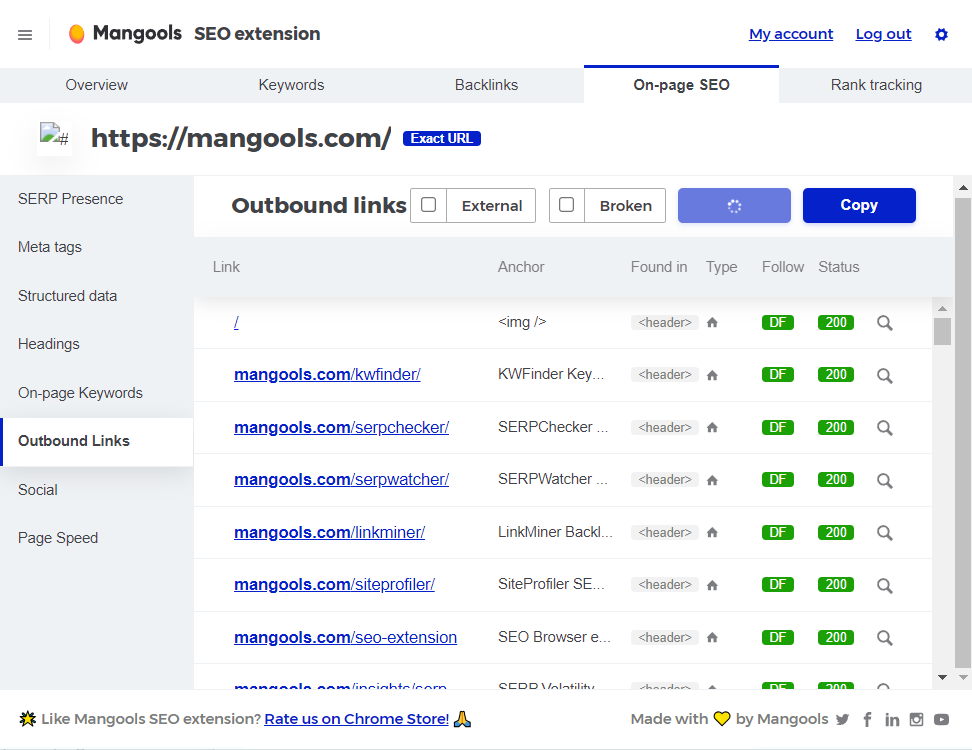
Here, you can filter external and broken links to help you fix any issues before they become critical.
8. Pages blocked by robots.txt
If the ‘robot.txt’ file blocks a page, it means no search engine is crawling it. As a result, that page may not contribute to PageRank distribution because it’s not indexed.
This file tells search engines not to access the page, so it won’t receive or pass on link juice. Such lapses can cause issues down the line, so make sure you fix them as soon as you notice.
9. URL redirects and canonical tags
URL redirects and canonical tags manage duplicate content and consolidate PageRank to a single page.
For example, a 301 redirect permanently moves pages to the new URL to preserve the original Page Rank.
Similarly, a canonical tag tells Goole what the preferred version of a page is, so that it attributes PageRank correctly.
Redirects and canonical tags ensure that search engines prioritize the right content to avoid dilution and a loss of the site’s authority.
10. Nofollow meta tags
Nofollow meta tags instruct search engines not to pass link juice to linked pages.
Adding ‘<meta name=”robots” content=”nofollow”>’ to a page prevents search engines from following any links on that page, thus not passing PageRank to them.
This helps the webmaster control the distribution of PageRank and focus it on the most relevant pages, the ones that will help users the most.
Since Google has stopped publicly sharing PageRank data, it’s no longer possible to measure your Page Rank score.
However, that doesn’t mean you can’t measure anything.
There are several alternatives that can provide insights into a site’s authority and link profile.
Domain Authority & Page Authority
Domain Authority (DA) is a metric developed by Moz that predicts how likely a website is to rank on search engine results pages (SERPs).
It scores websites on a 100-point scale, where higher scores indicate a greater ranking ability.
While this is a helpful metric, it’s not an official Google ranking factor and it’s more comprehensive than PageRank.
To calculate DA, SEO tools measure:
- Domain age
- Link diversity
- Spam signals
- Value distribution
- Internal and external links
Page Authority (PA) focuses on the likelihood of individual pages ranking on the SERPs.
Both metrics are calculated based on factors like the number and quality of backlinks, the linking root domains, and Moz’s proprietary algorithm.
If you use the free Mangools SiteProfiler, you can see both metrics in a snap.
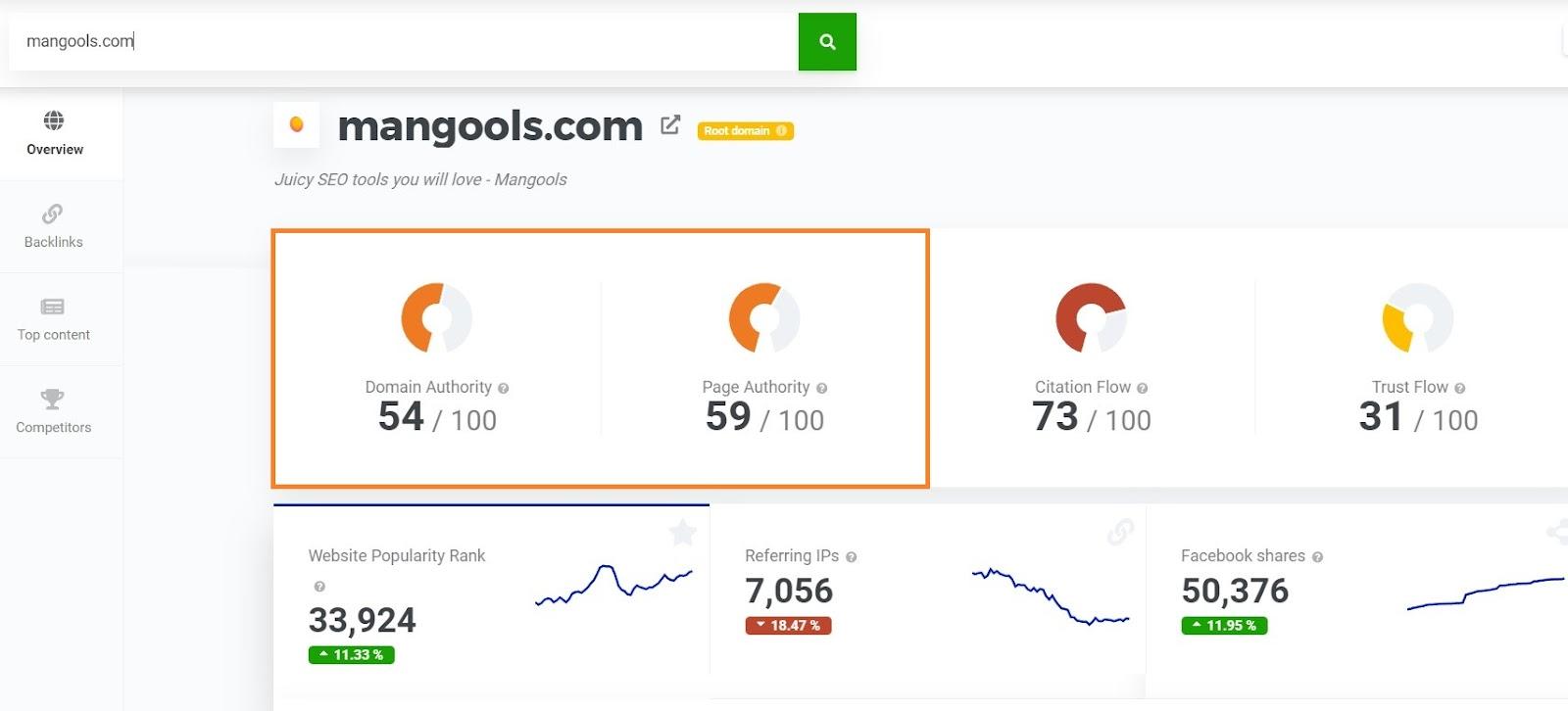
Domain Rating & URL Rating
Domain Rating (DR) is a logarithmic metric created by Ahrefs that measures the strength of a website’s entire backlink profile on a scale from 0 to 100.
URL Rating (UR), on the other hand, assesses the backlink profile of a specific URL.
These ratings consider factors like the quantity and quality of backlinks, with a focus on how much link juice a page might pass to another.
Unlike DA and PA, DR and UR give more weight to the quality of the links. By considering them, you can evaluate the impact of the sites linking to your content.
Citation Flow & Trust Flow
Citation Flow and Trust Flow are metrics developed by Majestic that separate the influence of a site’s backlinks into two categories: quantity and quality.
Citation Flow measures the number of backlinks a website has and predicts how influential it might be based on it.
On the other hand, Trust Flow assesses the quality of those backlinks and evaluates how trustworthy a site is. Sites closely linked to a trusted seed site should see higher scores.
A high Citation Flow with a low Trust Flow can indicate a site with many low-quality or spammy links, so these two metrics in tandem can give you a 360 view of your links.
You can also see these in the Mangools SiteProfiler dashboard.

To improve your Page Rank, focus on aspects that tackle your website’s authority. For example, you can:
Obtain more backlinks
Gaining backlinks is a fundamental strategy to improve your Page Rank, as it’s the basis of the algorithm itself.
But getting just any backlinks won’t do – you need high-quality links from authoritative sources in your industry.
For example, if your website is about digital marketing, getting a backlink from HubSpot can boost your PageRank much more than one from an amateur blog.
To get more links to your content, you can use some link-building techniques like:
- Guest blogging
- Content outreach
- Broken link building
- Resource link building
- HARO (Help a Reporter Out)
Or, just use Mangools’ LinkMiner tool, look up a competitor’s most powerful backlinks, and get to work.

You can even save your best finds into a separate list for easy navigation. Find them in the “Favorites” tab at the top.

Inside your Favorites list, you also see important metrics about your saved backlinks, which can help you determine their quality.

In order to evaluate the quality of “mined” backlinks, you can use multiple SEO metrics from the tool (and therefore have a better picture about the potential PageRank value passing to your website with selected backlinks) such as:
Create a FREE account
Improve internal linking
Optimizing internal linking is great to do to distribute PageRank across your site. To get the most bang for your buck, don’t interlink aimlessly, but intentionally.
For instance, if you have a high-traffic article on “SEO best practices,” link it to your other important pages, like a guide on “On-Page SEO Techniques” or your “SEO Services” page.
Having a structure helps you visualize how your popular pages pass PageRank to other pages.
Plus, it helps users find related content in a blink. Make sure your homepage links to other important pages on the site in the header:

And the footer:

Fix or redirect broken pages
Broken pages, or 404 errors, negatively impact your PageRank. Whenever you change something significant on your website, go back to see if you need a proper redirect.
For example, if you removed a product page from your e-commerce site, set up a 301 redirect to send users to the relevant category page instead. That way, you’ll preserve your PageRank and keep users engaged with similar content.
Avoid orphan pages
Orphan pages are pages without internal links pointing to them. This makes them hard for search engines to discover and index.
These pages can seriously harm your SEO efforts because the crawlers can’t find pages you don’t link to.
This will slow the crawlers down and halt the transfer of PageRank. Since the orphan page doesn’t have any internal links, Google won’t understand its significance within your site.
Avoid this by ensuring every page is linked to from another relevant page. Make your site accessible to both users and search engines.
Focus on broken links
Last but not least, regularly check for and address broken links within your site and on external sites linking to you.
If an external site links to your page that has since moved or been deleted, shoot a message to the site’s owner to update the link so that it can still pass along link juice.
When you find a broken link, update it or set up 301 redirects to the correct page. In any case, don’t let broken links hang around and disrupt the flow of PageRank.
You can also use the Mangools SEO extension to find broken links on other sites which you can then direct to yours.
Find a relevant page, check the “Broken” tab, look for a backlink pointing to a 404 page, and message the owner to change it with a link to your site.
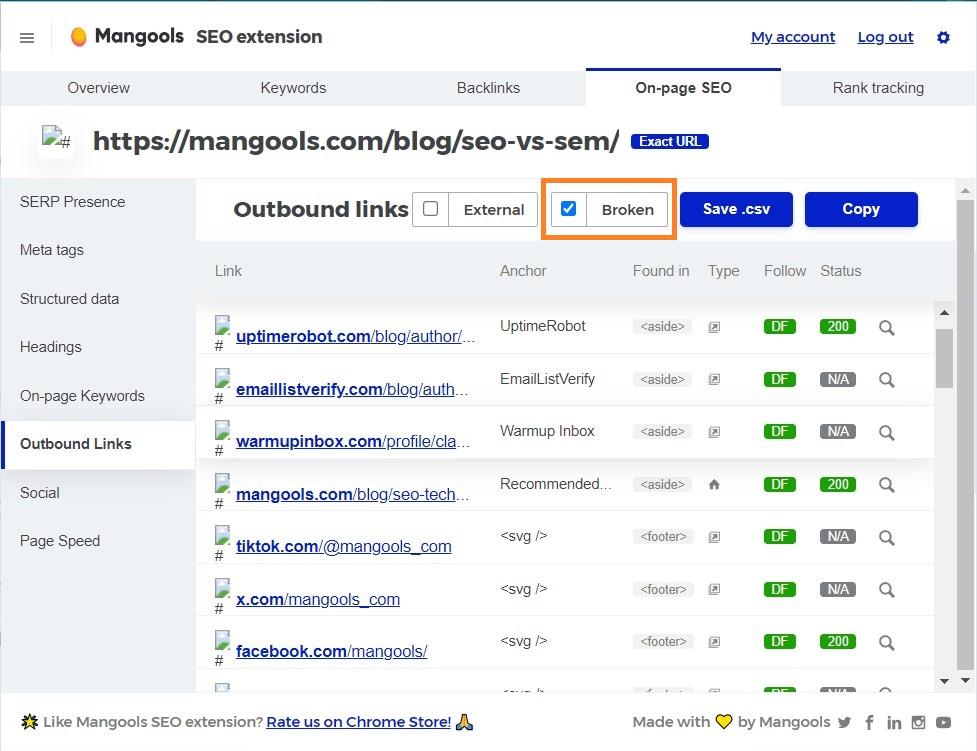
Frequently asked questions
Does Google still use PageRank?
Yes, Google still uses PageRank, but not as the only factor that determines the ranking of search results.
Who created Google PageRank?
Google PageRank is the brainchild of Google co-founders Larry Page and Sergey Brin. The Stanford University graduates published a paper on “The Anatomy of a Large-Scale Hypertextual Web Search Engine” in 1998 where they mentioned the factor for the first time.
How often is PageRank updated?
Since Google no longer publicizes Page Rank scores, we can’t know for sure how quickly it evaluates a page. But, many assume it happens every three to four months.
Is the Google Search algorithm patented?
The original PageRank patent expired in 2018, but Google now holds an updated, more comprehensive patent.
What is the original PageRank formula?
The original PageRank formula is: 𝑃𝑅(𝐴)=(1−𝑑)+𝑑(𝑃𝑅(𝑇1)/𝐶(𝑇1)+…+𝑃𝑅(𝑇𝑛)/𝐶(𝑇𝑛)).
What is the PageRank toolbar?
The Toolbar PageRank is a defunct metric search engine used to evaluate page relevance and significance. It displayed a page’s PageRank as a number between 0 and 10 in the toolbar.
